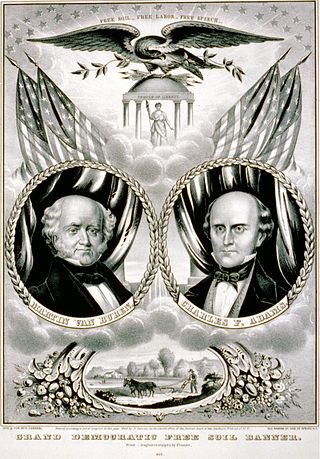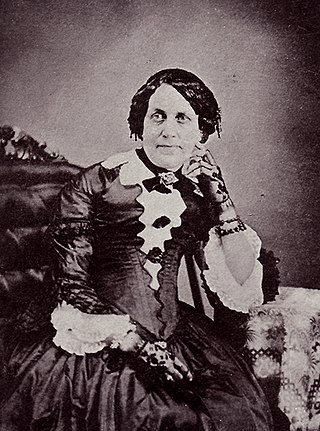Related Research Articles

Abolitionism, or the abolitionist movement, is the movement to end slavery and liberate enslaved people around the world.

Gamaliel Bailey was an American physician who left that career to become an abolitionist journalist, editor, and publisher, working primarily in Cincinnati, and Washington, D.C. Anti-abolitionist mobs attacked his offices in both cities during the 1840s.

The Free Soil Party was a short-lived coalition political party in the United States active from 1848 to 1854, when it merged into the Republican Party. The party was largely focused on the single issue of opposing the expansion of slavery into the western territories of the United States.

The Pearl incident was the largest recorded nonviolent escape attempt by enslaved people in United States history. On April 15, 1848, seventy-seven slaves attempted to escape Washington D.C. by sailing away on a schooner called The Pearl. Their plan was to sail south on the Potomac River, then north up the Chesapeake Bay and Delaware River to the free state of New Jersey, a distance of nearly 225 miles (362 km). The attempt was organized by both abolitionist whites and free blacks, who expanded the plan to include many more enslaved people. Paul Jennings, a former slave who had served President James Madison, helped plan the escape.
The Impending Crisis of the South: How to Meet It is an 1857 book by Hinton Rowan Helper, who declares himself a proud Southerner. It was written mostly in Baltimore, but it would have been illegal to publish it there, as he pointed out. It was a strong attack on slavery as inefficient and a barrier to the economic advancement of whites. The book was widely distributed by Horace Greeley and other antislavery leaders, and infuriated Southerners. According to historian George M. Fredrickson, "it would not be difficult to make a case for The Impending Crisis as the most important single book, in terms of its political impact, that has ever been published in the United States. Even more perhaps than Uncle Tom's Cabin, it fed the fires of sectional controversy leading up to the Civil War; for it had the distinction of being the only book in American history to become the center of bitter and prolonged Congressional debate". In the Northern United States, it became "the book against slavery." A book reviewer wrote, "Next to Uncle Tom's Cabin (1852), Hinton Helper's critique of slavery and the Southern class system, The Impending Crisis of the South (1857), was arguably the most important antislavery book of the 1850s."

The Religious Society of Friends, better known as the Quakers, played a major role in the abolition movement against slavery in both the United Kingdom and in the United States. Quakers were among the first white people to denounce slavery in the American colonies and Europe, and the Society of Friends became the first organization to take a collective stand against both slavery and the slave trade, later spearheading the international and ecumenical campaigns against slavery.

Lewis Tappan was a New York abolitionist who worked to achieve freedom for the enslaved Africans aboard the Amistad. He was born in Northampton, Massachusetts, into a Calvinist household.

Proslavery is support for slavery. It is sometimes found in the thought of ancient philosophers, religious texts, and in American and British writings especially before the American Civil War but also later through the 20th century. Arguments in favor of slavery include deference to the Bible and thus to God, some people being natural slaves in need of supervision, slaves often being better off than the poorest non-slaves, practical social benefit for the society as a whole, and slavery being a time-proven practice by multiple great civilizations.

Mary Edmonson (1832–1853) and Emily Edmonson, "two respectable young women of light complexion", were African Americans who became celebrities in the United States abolitionist movement after gaining their freedom from slavery. On April 15, 1848, they were among the 77 slaves who tried to escape from Washington, DC on the schooner The Pearl to sail up the Chesapeake Bay to freedom in New Jersey.

The pre-American Civil War practice of kidnapping into slavery in the United States occurred in both free and slave states, and both fugitive slaves and free negroes were transported to slave markets and sold, often multiple times. There were also rewards for the return of fugitives. Three types of kidnapping methods were employed: physical abduction, inveiglement of free blacks, and apprehension of fugitives. The enslavement, or re-enslavement, of free blacks occurred for 85 years, from 1780 to 1865.
The Liberty Party was an abolitionist political party in the United States prior to the American Civil War. The party experienced its greatest activity during the 1840s, while remnants persisted as late as 1860. It supported James G. Birney in the presidential elections of 1840 and 1844. Others who attained prominence as leaders of the Liberty Party included Gerrit Smith, Salmon P. Chase, Henry Highland Garnet, Henry Bibb, and William Goodell. They attempted to work within the federal system created by the United States Constitution to diminish the political influence of the Slave Power and advance the cause of universal emancipation and an integrated, egalitarian society.

Charles Turner Torrey was a leading American abolitionist. Although largely lost to historians until recently, Torrey pushed the abolitionist movement to more political and aggressive strategies, including setting up one of the first highly organized lines for the Underground Railroad and personally freeing approximately 400 slaves. Torrey also worked closely with free blacks, thus becoming one of the first to consider them partners. John Brown cited Torrey as one of the three abolitionists he looked to as models for his own efforts.

In the United States, abolitionism, the movement that sought to end slavery in the country, was active from the late colonial era until the American Civil War, the end of which brought about the abolition of American slavery for non-criminals through the Thirteenth Amendment to the United States Constitution.

William Lawrence Chaplin was a prominent abolitionist in the years before the American Civil War. Known by the title of "General," he was an agent for the American Anti-Slavery Society and a general agent for the Underground Railroad. He was imprisoned for the attempted escape of two individuals, which required $25,000 to get out of jail and safely out of Maryland. He was an editor at two anti-slavery newspapers and he was a Harvard-educated lawyer for a couple of years. He and his wife operated the Glen Haven Water Cure spa in his later years.
Thomas Smallwood (1801–1883) was a freedman," a daring activist and searing writer" who worked alongside fellow abolitionist Charles Turner Torrey on the Underground railroad. The two men created what some historians believe was the first branch of the underground railroad that ran through Washington, D.C., which they operated from 1842 to 1844. After their involvement ceased, the network continued to exist in Washington for another two decades. Smallwood also wrote for Torrey's Albany, New York antislavery newspaper, Tocsin of Liberty, as its Washington correspondent.

Emma V. Brown was an American educator and activist for racial equality. In 1864, she became the head teacher at Lincoln School, the first public school established in Washington, D.C. for the education of black students.

Jonathan H. Earle is an author, historian, professor, and dean. He is an historian of American politics and culture who focuses on the early republic and antebellum periods, especially the antislavery movement and the sectional crisis leading up to the Civil War. Currently Earle serves as Dean of the Roger Hadfield Ogden Honors College at Louisiana State University, a post he has held since 2014.

In the District of Columbia, the slave trade was legal from its creation until it was outlawed as part of the Compromise of 1850. That restrictions on slavery in the District were probably coming was a major factor in the retrocession of the Virginia part of the District back to Virginia in 1847. Thus the large slave-trading businesses in Alexandria, such as Franklin & Armfield, could continue their operations in Virginia, where slavery was more secure.
In Marion, Ohio, in July 1839, William Mitchell was seized by a group of men from Virginia, who alleged that he was an escaped slave. Mitchell, who had been living in Marion for at least a year, was placed on trial under Ohio's 1839 Fugitive Slave Act in the Court of Common Pleas, headed by Ozias Bowen. On August 27, in front of a packed courthouse, Bowen ruled against the Virginians and declared Mitchell to be free. After his ruling, the Virginians attempted to kidnap Mitchell. The crowd reacted in an effort to protect Mitchell, throwing projectiles at the Virginians while they were in the streets, and breaking into the town's armory and distributing weapons. Mitchell was soon freed and escaped to Canada.
This bibliography of slavery in the United States is a guide to books documenting the history of slavery in the U.S., from its colonial origins in the 17th century through the adoption of the 13th Amendment to the Constitution, which officially abolished the practice in 1865. In addition, links are provided to related bibliographies and articles elsewhere in Wikipedia.
References
- ↑ "Stanley Harrold | C-SPAN.org". www.c-span.org.
- ↑ "South Carolina State University". www.scsu.edu.
- ↑ Krohn, Raymond James (2013). "Border War: Fighting over Slavery before the Civil War by Stanley Harrold (Review)". Ohio History. 120: 141–143. doi:10.1353/ohh.2013.0013. S2CID 143844918.
- ↑ Wingert, Cooper. "Stanley Harrold – Border War (2010) | Slave Stampedes on the Missouri Borderland".
- ↑ Harrold, Stanley (February 23, 2013). Border War: Fighting Over Slavery Before the Civil War. University of North Carolina Press. ISBN 9781469606859 – via Google Books.
- ↑ "Harrold, Stanley [WorldCat Identities]".
- ↑ Harrold, Stanley (June 23, 2003). Subversives: Antislavery Community in Washington, D.C., 1828-1865. Louisiana State University Press. ISBN 9780807128053 – via Google Books.
- ↑ Masur, Kate (May 23, 2004). "Review of Stanley Harrold, Subversives: Antislavery Community in Washington, D.C., 1828-1865 (2002)". Journal of Southern History. 70 (2): 423–424. doi:10.2307/27648418. JSTOR 27648418 – via www.scholars.northwestern.edu.
- ↑ "McDaniel on Harrold, 'The Rise of Aggressive Abolitionism: Addresses to the Slaves' | H-SHEAR | H-Net". networks.h-net.org.
- ↑ Hamm, Thomas D. (1988-09-01). "Gamaliel Bailey and Antislavery Union by Stanley Harrold". Indiana Magazine of History. ISSN 1942-9711.
- ↑ Harrold, Stanley (June 23, 1986). Gamaliel Bailey and antislavery union. Kent State University Press. ISBN 9780873383295 – via Google Books.